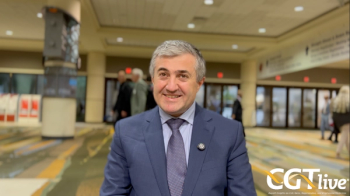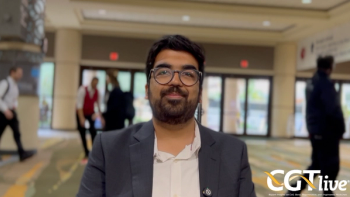
Beti-Cel Confers Durable Efficacy, Improved Quality of Life in Beta-Thalassemia
100% of patients who achieved transfusion independence reported an overall benefit from treatment.
bluebird bio’s betibeglogene autotemcel (beti-cel; Zynteglo), a gene therapy
Among the 63 patients evaluated across the phase 1/2 (HGB-204, NCT01745120; HGB-205, NCT02151526) and phase 3 (HGB-207, NCT02906202; HGB-212, NCT03207009) clinical trials, 52 patients achieved transfusion independence, including 68.2% in the phase 1/2 studies and 90.2% in the phase 3 studies.1 The substantial improvement in phase 3 was attributed to an optimized manufacturing process. Mark Walters, MD, of UCSF Benioff Children's Hospital, who presented the efficacy and safety data, noted that no significant differences in TI achievement were observed with regard to patient age or genotype (β0/β0 versus non-β0/β0). He also pointed out that most of the patients in the study populations had elevated hepatic iron, and that there was no cardiac iron loading.
“The optimized manufacturing protocol resulted in improved vector copy number (VCN) and hemoglobin (Hb) that reached nearly 12 grams/dL at 60 months post-infusion in the phase 3 studies...” Walters stated during his presentation.1 He also discussed an exploratory analysis of predictors of outcomes, noting that, “The [other] key efficacy takeaway is that patients who achieved TI also had reductions in markers of ineffective erythropoiesis (although these didn’t go away completely) and iron overload. The exploratory multivariate analysis showed that the percentage of lentiviral positive cells in the beti-cel drug product was the best predictor of clinical outcomes, and in fact a threshold of 62% transduced cells in the drug product increased the likelihood of achieving TI.”
In terms of safety, 19% of patients experienced at least 1 adverse event (AE) that was determined to be related or possibly related to beti-cel. Five cases of abdominal pain, 3 cases of thrombocytopenia, and single-patient cases of immune thrombocytopenia, leukopenia, neutropenia, tachycardia, dysplasia, non-cardiac chest pain, pain in extremity, focal nodular hyperplasia, dyspnea, and hot flush were among the AEs considered related or possibly related to beti-cel. Veno-occlusive liver disease (VOD) was observed in 7 of the 63 patients but resolved after appropriate treatment. Serious AEs occurring in at least 2 patients included 5 cases of VOD, 5 cases of pyrexia, 3 cases of neutropenia, 3 cases of thrombocytopenia, 3 cases of sepsis events, 2 cases of appendicitis, 2 cases of febrile neutropenia, 2 cases of major depression, and 2 cases of stomatitis. It was noted that no malignancies, insertional oncogenesis, vector-derived replication competent lentivirus, or clonal predominance were observed in the patients.
A separate analysis of patient-reported QoL data from a long-term follow-up study (LTF-303; NCT02633943) presented by Franco Locatelli, MD, IRCCS Ospedale Pediatrico Bambino Gesú, Catholic University of the Sacred Heart, showed that patients treated with beti-cel who achieved TI reported improvements across several metrics.2 At 3 years post-treatment, 93% were employed or able to seek employment compared with 67% at baseline, and 50% had absences from school compared with 95% of patients at baseline. In addition, 45% no longer required management of disease symptoms, 81% reported improvement in physical activity, and 100% reported an overall benefit from the treatment.
The data demonstrate that beti-cel is a potentially curative option for patients regardless of age and genotype, with durable TI observed for up to 8 years post-treatment thus far. In addition, the gene therapy appears to confer QoL improvements even compared to relatively high baseline scores.
For more coverage of ASH 2022,
REFERENCES
1. Walters, M, Kwiatkowski JL, Porter JB, et al. Long term outcomes of 63 patients with transfusion-dependent β-thalassemia (TDT) followed up to 7 years post-treatment with betibeglogeneautotemcel (beti-cel) gene therapy and exploratory analysis of predictors of successful treatment outcomes in phase 3 trials. Presented at: ASH 2022 Annual Meeting. December 10-12, 2022; New Orleans, LA. Abstract 2348
2. Locatelli F, Walters M, Kwiatkowski JL, eat al.Long-term patient-reported outcomes following treatment with betibeglogeneautotemcel in patients with transfusion-dependent β-thalassemia. Presented at: ASH 2022 Annual Meeting. December 10-12, 2022; New Orleans, LA. Abstract 440 Abstract 3665
3. bluebird bio Announces FDA approval of ZYNTEGLO, the first gene therapy for people with beta-thalassemia who require regular red blood cell transfusions. News release. bluebird bio. August 17, 2022.
Newsletter
Stay at the forefront of cutting-edge science with CGT—your direct line to expert insights, breakthrough data, and real-time coverage of the latest advancements in cell and gene therapy.

















































